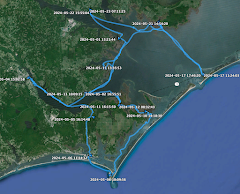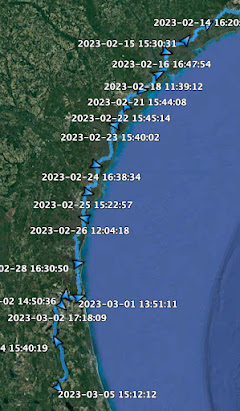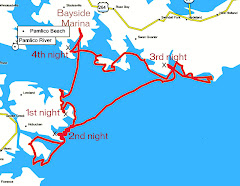 Ever since Bruce read the safety requirements for the Yukon 1000 we have had an ongoing discussion about safety gear and how to use it on Spartina. I think we have been well equipped on all of our trips but we try to learn and improve as we go along.
Ever since Bruce read the safety requirements for the Yukon 1000 we have had an ongoing discussion about safety gear and how to use it on Spartina. I think we have been well equipped on all of our trips but we try to learn and improve as we go along. Bruce has been asking the question "What do we do if something goes wrong?" I remember thinking a lot about that before my first solo sail on Spartina three years ago. At that time I came across an article (can't remember where) that discussed "the small boat as a lifeboat theory". In the event of a capsize, broken mast or injury the first step is to consider the boat you are in as a lifeboat. Spartina as a lifeboat? Why not? It has all the safety gear on board, positive flotation, hypothermia kits, first aid kits, satellite beacons, food and water. The boat may be damaged or flooded but it will most likely float, so use it as a survival tool. Bruce and I have always done this even if we never really talked it through. Part of our SPOT 911 message states "we will remain with boat for as long as possible."
 We always wear our inflatable life vests (a gift to the boat from Bruce) and in anything but the calmest weather we are tethered to the boat (when solo sailing I'm always tethered to the boat). I've got a safety light clipped on my vest, Bruce is getting one to put on his. And we each have whistles on the vests.
We always wear our inflatable life vests (a gift to the boat from Bruce) and in anything but the calmest weather we are tethered to the boat (when solo sailing I'm always tethered to the boat). I've got a safety light clipped on my vest, Bruce is getting one to put on his. And we each have whistles on the vests.
 So Spartina as a lifeboat is Plan A. So what is Plan B? What if we have a problem that causes us to leave the boat? Maybe a fire or the watertight portions of the hull are ruptured and the boat sinks. In that case we grab and activate our SPOTS (we each have one), plus Bruce's epirb, the waterproof radio and the watertight duffels that we each have stowed up forward in the cockpit. Those duffels will float, giving us something to hang on to, and increase our visibility from the air (mine is yellow and I think Bruce's is orange) . Inside the duffels are extra clothes and complete Watertribe inspired hypothermia kits. (A note on equipment color - My sleeping pad is bright green, my bivy is orange, my foul weather gear is yellow. I want the bright colors around me to make it easier for search and rescue teams).
So Spartina as a lifeboat is Plan A. So what is Plan B? What if we have a problem that causes us to leave the boat? Maybe a fire or the watertight portions of the hull are ruptured and the boat sinks. In that case we grab and activate our SPOTS (we each have one), plus Bruce's epirb, the waterproof radio and the watertight duffels that we each have stowed up forward in the cockpit. Those duffels will float, giving us something to hang on to, and increase our visibility from the air (mine is yellow and I think Bruce's is orange) . Inside the duffels are extra clothes and complete Watertribe inspired hypothermia kits. (A note on equipment color - My sleeping pad is bright green, my bivy is orange, my foul weather gear is yellow. I want the bright colors around me to make it easier for search and rescue teams).
 What if there isn't time to grab the duffels? That will be Plan C, something new we will have ready to go on this trip. Plan C includes two small watertight pouches that will have flashlights, signaling mirrors, fire starter tool and some first aid items. Hopefully we would have time to grab the SPOTS, clip them and the survival pouches to our vests. The pouches will be stored up under the coaming on the port side of the aft cockpit next to the throw rope (another safety item!).
What if there isn't time to grab the duffels? That will be Plan C, something new we will have ready to go on this trip. Plan C includes two small watertight pouches that will have flashlights, signaling mirrors, fire starter tool and some first aid items. Hopefully we would have time to grab the SPOTS, clip them and the survival pouches to our vests. The pouches will be stored up under the coaming on the port side of the aft cockpit next to the throw rope (another safety item!).
 This sounds more complicated than it really is. We've got virtually all the gear already. It is just a matter of having it organized and easily available. And - most importantly - having a plan on how to use it.
This sounds more complicated than it really is. We've got virtually all the gear already. It is just a matter of having it organized and easily available. And - most importantly - having a plan on how to use it.
 We always wear our inflatable life vests (a gift to the boat from Bruce) and in anything but the calmest weather we are tethered to the boat (when solo sailing I'm always tethered to the boat). I've got a safety light clipped on my vest, Bruce is getting one to put on his. And we each have whistles on the vests.
We always wear our inflatable life vests (a gift to the boat from Bruce) and in anything but the calmest weather we are tethered to the boat (when solo sailing I'm always tethered to the boat). I've got a safety light clipped on my vest, Bruce is getting one to put on his. And we each have whistles on the vests. So Spartina as a lifeboat is Plan A. So what is Plan B? What if we have a problem that causes us to leave the boat? Maybe a fire or the watertight portions of the hull are ruptured and the boat sinks. In that case we grab and activate our SPOTS (we each have one), plus Bruce's epirb, the waterproof radio and the watertight duffels that we each have stowed up forward in the cockpit. Those duffels will float, giving us something to hang on to, and increase our visibility from the air (mine is yellow and I think Bruce's is orange) . Inside the duffels are extra clothes and complete Watertribe inspired hypothermia kits. (A note on equipment color - My sleeping pad is bright green, my bivy is orange, my foul weather gear is yellow. I want the bright colors around me to make it easier for search and rescue teams).
So Spartina as a lifeboat is Plan A. So what is Plan B? What if we have a problem that causes us to leave the boat? Maybe a fire or the watertight portions of the hull are ruptured and the boat sinks. In that case we grab and activate our SPOTS (we each have one), plus Bruce's epirb, the waterproof radio and the watertight duffels that we each have stowed up forward in the cockpit. Those duffels will float, giving us something to hang on to, and increase our visibility from the air (mine is yellow and I think Bruce's is orange) . Inside the duffels are extra clothes and complete Watertribe inspired hypothermia kits. (A note on equipment color - My sleeping pad is bright green, my bivy is orange, my foul weather gear is yellow. I want the bright colors around me to make it easier for search and rescue teams). What if there isn't time to grab the duffels? That will be Plan C, something new we will have ready to go on this trip. Plan C includes two small watertight pouches that will have flashlights, signaling mirrors, fire starter tool and some first aid items. Hopefully we would have time to grab the SPOTS, clip them and the survival pouches to our vests. The pouches will be stored up under the coaming on the port side of the aft cockpit next to the throw rope (another safety item!).
What if there isn't time to grab the duffels? That will be Plan C, something new we will have ready to go on this trip. Plan C includes two small watertight pouches that will have flashlights, signaling mirrors, fire starter tool and some first aid items. Hopefully we would have time to grab the SPOTS, clip them and the survival pouches to our vests. The pouches will be stored up under the coaming on the port side of the aft cockpit next to the throw rope (another safety item!). This sounds more complicated than it really is. We've got virtually all the gear already. It is just a matter of having it organized and easily available. And - most importantly - having a plan on how to use it.
This sounds more complicated than it really is. We've got virtually all the gear already. It is just a matter of having it organized and easily available. And - most importantly - having a plan on how to use it. (For another safety item look at the photo above. You can see a line around the stern cleat. That is part of a boarding ladder than can be reached and deployed from outside of the boat).
I've spent a lot of time with the Coast Guard and I've been impressed with their training and planning, the step by step systematic approach to dealing with issues. I think we'll take the same approach on Spartina. Plan A - Spartina is a lifeboat. Plan B - grab the duffels, SPOTs, epirb and radio. Plan C - grab the SPOTs, radio and survival pouch. Plan D - grab the SPOTs and inflate the life jackets.
In the cruising that I have done, with Bruce or solo, I've never had a problem where I was concerned about my safety. Once I was anchored when a weather front with funnel clouds passed over. I thought their was a tiny, tiny chance of being hit by a tornado. I got out my duffel, clipped my SPOT and radio to it and kept it by my side as I read a nice book under the boom tent. That is as close as I've been to using any safety gear. But we do want (need) to be prepared.
If anybody out there has experience in this area, ideas or comments, we would appreciate hearing from you.
Steve










































6 comments:
Steve, With my limited experience with survival gear, the Penguin suit or full survival suit is a great addition. I have had some training in their use when I worked in a remote mine on the coast. They are good for the north Atlantic and provides 1hr+ of survival time in winter conditions (Newfoundland) Other that that, you have made things as safe as can be reasonably done for such a sized craft. Another good idea is smoke canisters. A flare is brief and once burned out locating is much more difficult. But smoke lingers, even blows with the wind and at least has a way to be tracked back to possible origins. Not to mention seen from a long distance in the day.
Perry
When I see all this "stuff" I can't help but think of John Smith and his minimalist crew exploring the Chesapeake Bay for months at a time. They had almost nothing but their wit, sea savvy, and GUTS, plus they faced the risk of potentially hostile tribes. It makes their feat of exploration even more incredible!
If you get any more gear, your gonna have to get a bigger boat!
:-) Steve H.
Perry,
I did at one time look at the Penguin suits. I see their value, but in our area and during spring, summer, fall sailing I decided the possible benefits did not justify the cost/space. But in your area - I would definitely look at them.
Smoke canisters do sound like a good idea and will check in to them.
Shock,
I know what you mean. Those guys were tough.
steve
Our wives make us play nice and be safe.
Bruce
Hi Steve.
Love reading your stories. Keeps me motivated to complete our Pathfinder.
We have a small home based business here in NZ. www.406beaconhire.co.nz
I would highly recommend keeping your EPIRB in your coat pocket at all times. Esp when it gets rough. I did when I was adventure jetboating. We also have rented out beacons to sailors in the 'Around North Island Yacht Race.' The did the same. Kept one in there pockets whenever on deck. That way you are assured of having it on you at all times.
Also a flashing strobe so night vision can pick it up.
http://www.youtube.com/user/ACR406#play/uploads/6/8m78j0TIeVg
Cheers
Brian
Brian
thanks for your comments. Sounds like you have some experience in this area.
I see the value in keeping a beacon in the life jacket pocket. Unfortunately our jackets are low profile inflatable jackets with built in harnesses. You can see me wearing mine in the second photo of the post. There are no pockets, but there is a clip for a light (mine is there to the right) and a whistle. I think the closest we can come is a bronze clip on the SPOT lanyard that we can hook on to the vest if things get rough. And yes we do have strobes/flashlights - need to put clips on those too.
It seems that the safety gear is a trade off --- cost, space, weight vs. need and chance that we will use it. For example the inflatable vests don't have pockets, but they are very comfortable in hot humid weather. Comfort is a safety factor as far as I'm concerned. What we can do is make the beacons and strobes easier/quicker to attach.
Bruce's epirb is the exact one you show on your web page. Between that and two SPOTS I would like to think we can be tracked. We just need to make sure they are accessible and easily attached.
Send me some photos of your Pathfinder. Good luck. Steve
Post a Comment